Big honking family
Mom & dad Canada Goose have to keep nine little ones in line. Seen in late April on the grounds of the Lake County Discovery Museum.
Mom & dad Canada Goose have to keep nine little ones in line. Seen in late April on the grounds of the Lake County Discovery Museum.
On Sunday we went out again with Lake-Cook Audubon, this time to an outing at McHenry Dam, which is part of Moraine Hills State Park in McHenry County. We took the Fox River trail which passes through meadow, marsh, wetland and forest habitat.
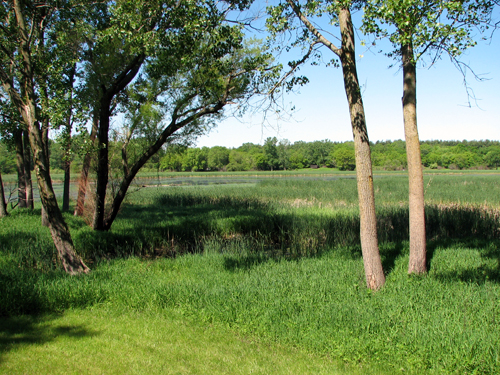

There are even two observation decks, including this one that almost looks like a blind!
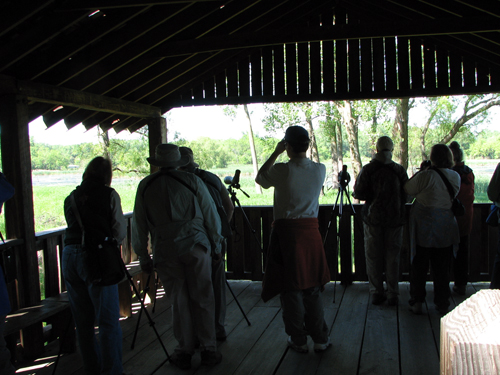
Arthur and I noted 37 observed species, with six lifers! Arthur also recently started using Birdstack (I started a while back but never finished) to record all bird species we have observed. Our ‘actual’ life list is now at 442 species total.
On one part of the trail, we observed a Common Yellowthroat, one of our six lifers on the outing.
The next 8 or 10 birds we saw were Yellowthroats, but each time we saw the movement of a bird in the bushes, we looked hopefully through our bins, looking for a new species. But they were all Yellowthroats. Well, they are Common – it’s true!
We also ran back to see this lifer Orchard Oriole that a few stragglers in our group found in a tree.
Besides birds we also saw lots of turtles, a rather large muskrat, and this huge bullfrog.

Another great outing with Lake-Cook Audubon!
Here are some of the more interesting search terms that brought visitors to this site during May. You can see previous editions of this monthly post here.
Searches for Magnificent Frigatebird-related information continue to bring visitors. Last month people searched for frigatebird bible, frigate birds natural enemies, magnificent frigate bird for children, frigate bird food chain, and how does a magnificent frigate reproduce? (what are the options for birds?).
Interesting and funny typos for the month include hummbird food, alalbama birdhouse, pigeon fancers, magnificient riffle bird, bird watching supplys, birders termanology, outdoor wildlife bird suppyies, and my favorite, sworowski monoculr.
I noticed a lot of searches for birdhouses and birdfeeders last month. Some of the search terms sound pretty funny to me, but most of them were for houses or feeders that are actually available for purchase, like these: bird house airstream; hummsicle; pirate birdhouse; and diving cat bird bath.
My favorite funny search terms for May were do loons breed in illinois? (a question I had myself a couple of months ago), rectangle scope (ouch!), passerine turkey, and quiet birding clothing.
Last week I was wondering if we’d ever cycle to our favorite local preserve, Rollins Savanna. Well, the weather was perfect on Saturday so we went for it! There was a bit more mud than expected, but there was also a lot more bike path than we dreamed of, so the trip was a big success!
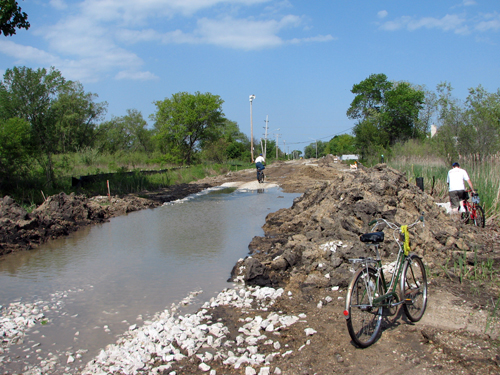
I wrote about it on our personal blog – go check it out!
Today Arthur and my dad made a bird feeder pole for our back yard. First we all went to Home Depot to pick up the materials. The pole system is based on several feeders my parents have, all made by my dad. We used black pipes normally used for natural gas and/or plumbing systems. For this project we used:
One 2′ long, 1 inch diameter pipe (“the base”)
One 10′ long, 1/2 inch diameter pipe (“the long pole”)
One 18″ long, 1/2 inch diameter pipe (“the arm”)
One 1/2 T-section joint
Two 1/2 inch end caps
Two each: S-hook, nut/bolt, large washer, small washer
At Home Depot, we had an 18″ piece cut off the 10-foot pipe, and the cut side of the 18″ pipe threaded.
Here are Arthur and my dad preparing for the project. (My dad’s wearing dark glasses because he just had lens replacement surgery on his eyes.)

First, the T-section was screwed onto the top of the long pole.
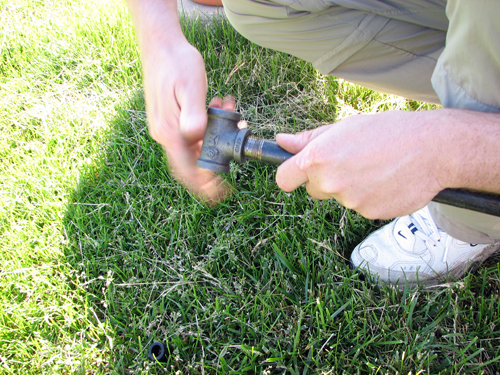
Both 18″ arms were then screwed into the sides of the T-section.
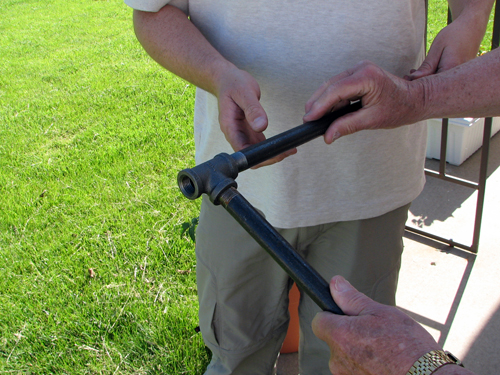

They used a drill to cut holes in the end caps and then used the bolts, nuts & washers to secure the S-hooks to the ends of the caps. Pliers were used to tighten the S-hook around the bolt. The end-caps were then screwed onto the ends of the arms.


We then used a sledgehammer to pound the base pipe directly into the ground. We first hammered one end of the pipe in slightly, to prevent too much dirt entering the pipe from below. When the pipe was buried with only a few inches above the ground, we slid the long pole into the base. Since the pipes were not meant to nest this way, the long pole wobbled a bit. We used shims to make the fit more snug. I think the final result is pretty cool:

This system is much more substantial than the shepherd’s hooks we’re now using for our feeders. We can finally hang our Wingscapes Birdcam and hopefully get some more interesting shots than the ground images I’ve gotten over the past months. Here’s a sample we got late this afternoon.

A class of fifth-graders in Howell, Michigan spent two months studying the endangered Kirtland’s Warbler, compiling a book about the bird and concluding that it should replace the American Robin as their state bird. The bird nests primarily in Michigan (there are a few in Wisconsin, too) so it sounds like a good fit to me. (The American Robin is the state bird of Connecticut and Wisconsin as well. There are a couple of other birds that are the state bird of multiple states: the Northern Cardinal (7) and Western Meadowlark (6) come to mind. Nothing against these birds, but come on, how unoriginal!)
In case you’ve never seen this lovely bird, here’s a photo. What a beauty!

Read more about the students’ project here.
I thought this male House Sparrow was so cute, gathering nesting material on the grounds of the Chicago Botanic Garden. It looks like he’s intent to take the perfect piece of grass, but there’s a big chunk of mud stuck to it. He tries and tries to wiggle it off, but he gives up immediately when the missus shows up. She looks to be more practical in her search for nesting material.
On Sunday at Rollins we watched a pair of Sandhill Cranes with one young chick.

They were walking in the shallow water. The adults would forage and sometimes pass food to the chick, which you can see in the second part of the video.
Meet yard bird #18* – this lovely lady Northern Flicker. She was foraging in the back of the yard by the fence, and when I first saw her I thought she was a robin! What a pleasant surprise!

Flickers are the only woodpecker known to commonly feed on the ground. We think she might have been after ants. There is a large anthill behind the fence at the back of our yard and they often make their way on our side of the fence – especially now that we have oranges and grape jelly out for the orioles. Isn’t she striking? What beautiful markings!

Before she left the yard, she had a nice shake on our fence.
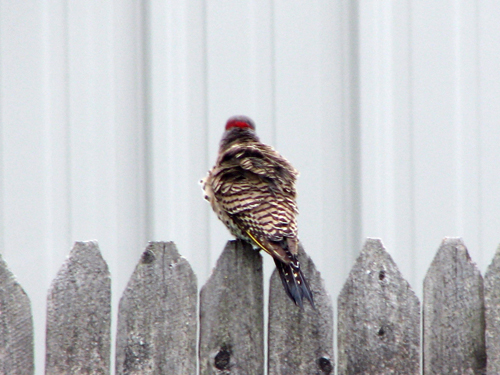
* I had previously counted a group of Canada Goose loitering on the roof of the warehouse behind our yard as ‘yard birds’. Since then we’ve had a few other species fly over but I haven’t counted those on our yard list. Since no Canada Goose has actually been in our yard I am not including that species on our list anymore. Our yard list is therefore:
1. American Goldfinch
2. Dark-eyed Junco (slate-colored)
3. Black-capped Chickadee
4. House Finch
5. Mourning Dove
6. House Sparrow
7. Northern Cardinal
8. Red-winged Blackbird
9. Song Sparrow
10. American Robin
11. Downy Woodpecker
12. Brown-headed Cowbird
13. European Starling
14. American Tree Sparrow
15. Common Grackle
16. White-crowned Sparrow
17. Baltimore Oriole
18. Northern Flicker